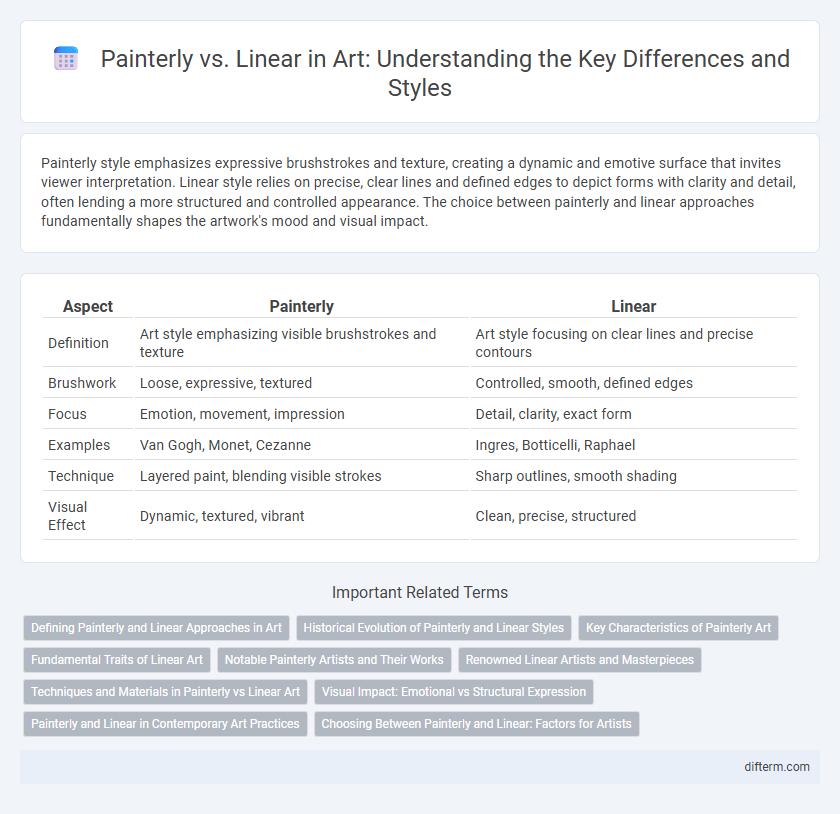Painterly style emphasizes expressive brushstrokes and texture, creating a dynamic and emotive surface that invites viewer interpretation. Linear style relies on precise, clear lines and defined edges to depict forms with clarity and detail, often lending a more structured and controlled appearance. The choice between painterly and linear approaches fundamentally shapes the artwork's mood and visual impact.
Table of Comparison
| Aspect | Painterly | Linear |
|---|---|---|
| Definition | Art style emphasizing visible brushstrokes and texture | Art style focusing on clear lines and precise contours |
| Brushwork | Loose, expressive, textured | Controlled, smooth, defined edges |
| Focus | Emotion, movement, impression | Detail, clarity, exact form |
| Examples | Van Gogh, Monet, Cezanne | Ingres, Botticelli, Raphael |
| Technique | Layered paint, blending visible strokes | Sharp outlines, smooth shading |
| Visual Effect | Dynamic, textured, vibrant | Clean, precise, structured |
Defining Painterly and Linear Approaches in Art
Painterly approaches emphasize visible brushstrokes, texture, and a focus on color and light to create expressive, dynamic compositions. Linear techniques prioritize precise lines, clear contours, and defined shapes, often resulting in crisp, detailed imagery. These contrasting methods shape the overall aesthetic and emotional impact of a work, reflecting distinct artistic intentions and styles.
Historical Evolution of Painterly and Linear Styles
Painterly and linear styles evolved distinctly throughout art history, with the painterly approach gaining prominence during the Baroque period through artists like Rembrandt and Rubens, emphasizing loose brushwork and dynamic texture. The linear style, rooted in Renaissance art, exemplified by Leonardo da Vinci and Botticelli, focused on precise outlines and clear forms to achieve clarity and structure. These contrasting techniques reflect shifting artistic priorities from emotional expression to anatomical accuracy and idealized representation.
Key Characteristics of Painterly Art
Painterly art emphasizes visible brushstrokes, dynamic texture, and a sense of movement within the composition. It often prioritizes color blending and tonal variation over defined edges, creating a rich, expressive surface that invites emotional engagement. This style contrasts with linear art by focusing on spontaneity and the physicality of paint application rather than precise contours.
Fundamental Traits of Linear Art
Linear art is characterized by the use of distinct, clean lines to define shapes and contours, emphasizing clarity and precision in form. It relies heavily on contour and outline to create structure, often minimizing shading to highlight the skeleton of the composition. This approach prioritizes drawing techniques and sharp edges, making it essential in disciplines like illustration, graphic design, and technical drawing.
Notable Painterly Artists and Their Works
Notable painterly artists like Vincent van Gogh and Claude Monet emphasize visible brushstrokes and vibrant color fields, creating dynamic texture and emotional intensity in works such as Van Gogh's "Starry Night" and Monet's "Water Lilies." Their technique contrasts sharply with linear artists, focusing on structure and clear contours rather than painterly softness. This approach revolutionized Impressionism and Post-Impressionism by prioritizing expressive surface and atmospheric effects.
Renowned Linear Artists and Masterpieces
Renowned linear artists like Albrecht Durer and Leonardo da Vinci exemplify precision and clarity through their masterful use of contour and fine lines to define form and structure. Durer's engravings and da Vinci's anatomical sketches showcase the meticulous detail and controlled line work characteristic of the linear style. These masterpieces emphasize crisp outlines and organized compositions, contrasting sharply with the more fluid and textured brushstrokes found in painterly approaches.
Techniques and Materials in Painterly vs Linear Art
Painterly techniques emphasize visible brushstrokes, texture, and a loose application of paint, often achieved with thick oil or acrylic mediums to create a sense of movement and depth. Linear art relies on precise, clean lines and contour delineation, typically using materials like ink, graphite, or fine brushes to achieve clarity and detail. The choice of materials directly influences the visual impact, with painterly works favoring expressive layering and blending, while linear styles prioritize sharpness and definition.
Visual Impact: Emotional vs Structural Expression
Painterly techniques emphasize emotional expression through dynamic brushstrokes, rich textures, and vibrant colors that evoke mood and movement. Linear methods prioritize structural clarity with precise lines and defined forms, guiding the viewer's understanding of composition and spatial relationships. The visual impact of painterly art is visceral and immediate, while linear art offers intellectual engagement through order and detail.
Painterly and Linear in Contemporary Art Practices
Painterly techniques in contemporary art emphasize visible brushstrokes and texture, creating dynamic surfaces that convey emotion and spontaneity. Linear approaches, by contrast, prioritize precise, defined lines and clear contours to establish structure and detail within compositions. Contemporary artists often blend painterly expressiveness with linear clarity to explore complex narratives and visual tension in their works.
Choosing Between Painterly and Linear: Factors for Artists
Artists weigh factors such as desired emotional expression and texture when choosing between painterly and linear styles. Painterly techniques emphasize brushstrokes and fluidity, creating dynamic, textured compositions, while linear styles prioritize precise lines and clear forms for focused detail. The choice impacts the artwork's mood, narrative clarity, and viewer engagement, influencing the overall artistic intention.
Painterly vs Linear Infographic

 difterm.com
difterm.com